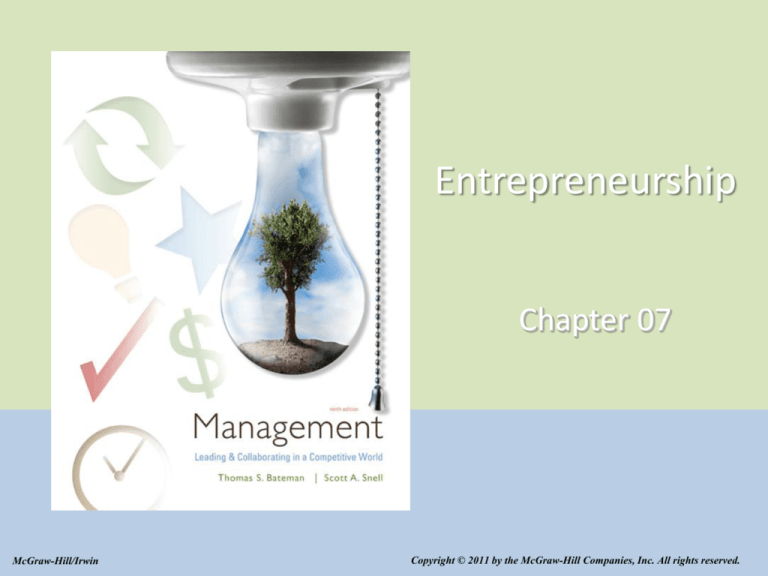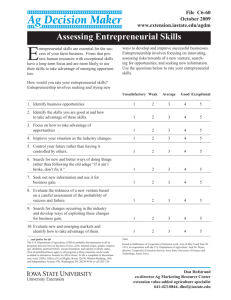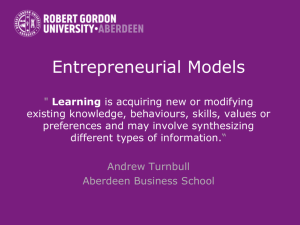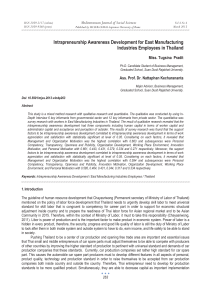
Entrepreneurship
Chapter 07
McGraw-Hill/Irwin
Copyright © 2011 by the McGraw-Hill Companies, Inc. All rights reserved.
Learning Objectives
LO1 Describe why people become entrepreneurs and what it
takes, personally
LO2 Summarize how to assess opportunities to start a new
company
LO3 Identify common causes of success and failure
LO4 Discuss common management challenges
LO5 Explain how to increase your chances of success, including
good business planning
LO6 Describe how managers of large companies can foster
intrapreneurship and an entrepreneurial orientation
7-2
Entrepreneurship
Entrepreneurship
The pursuit of lucrative opportunities by
enterprising individuals.
Entrepreneur
Individuals who establish a new organization
without the benefit of corporate sponsorship
Intrapreneurs
New-venture creators working inside big
companies.
7-3
Entrepreneurship
Small business
A business having fewer
than 100 employees,
independently owned
and operated, not
dominant in its field, and
not characterized by
many innovative
practices.
Entrepreneurial
venture
A new business having
growth and high
profitability as primary
objectives.
7-4
Some Myths About Entrepreneurship
7-5
Some Myths About Entrepreneurship
7-6
Mega-Entrepreneurs Who
Started in Their 20s
Table 7.2
7-7
Who is The Entrepreneur?
Figure 7.1
7-8
The Idea
A great product, a
viable market, and
good timing are
essential ingredients in
any recipe for success.
What else ?
7-9
What Business Should You Start?
An entrepreneur should consider opportunities in:
Technological
discoveries
Demographic
changes
Lifestyle and taste
changes
Screwed up
industries
Economic
dislocations
Calamities
Government
initiatives and rule
changes.
Skill, likes,success
7-10
What Business Should You Start?
Franchising
An entrepreneurial alliance between a franchisor
(an innovator who has created at least one
successful store and wants to grow) and a
franchisee (a partner who manages a new store of
the same type in a new location).
McDonalds
Fees, rules, %
7-11
The Internet
Transaction fee model
Charging fees for goods
and services.
Subscription model
Advertising support
model
Charging fees to
advertise on a site.
Charging fees for site
visits.
7-12
The Internet
Intermediary model
Charging fees to bring
buyers and sellers
together.
Affiliate model
Charging fees to direct
site visitors to other
companies’ sites.
7-13
What Does it Take, Personally?
1.
2.
3.
4.
5.
6.
7.
Commitment and determination
Leadership
Opportunity obsession
Tolerance of risk, ambiguity, and uncertainty
Creativity, self-reliance, and ability to adapt
Motivation to excel
What else?
7-14
Entrepreneurial Strategy
Matrix
Figure 7.2
7-15
Sources of Capital
7-16
Success and Failure
Anticipate risk---Business Plan
Consider the role of the economic environment
Utilize business incubators
Realize there are common management
challenges
Going public with an initial public offering (IPO)
Who, What, When, Where, Why and How
7-17
Common Management Challenges
You might not enjoy it
Survival is difficult
Growth creates new challenges, new
competitors
It’s hard to delegate
Misuse of funds, lack of funds
Poor controls
Mortality
Employees
7-18
Success and Failure
Business incubators
Protected
environments for
new, small
businesses
7-19
Going Public
Initial public offering (IPO)
Sale to the public, for the first time, of federally
registered and underwritten shares of stock in the
company
7-20
Increasing Your Chances of Success
Opportunity analysis
A description of the good or service, an
assessment of the opportunity, an assessment of
the entrepreneur, specification of activities and
resources needed to translate your idea into a
viable business, and your source(s) of capital.
7-21
Opportunity Analysis
Table 7.3
7-22
Planning
Business plan
A formal planning step
that focuses on the
entire venture and
describes all the
elements involved in
starting it.
Capital people will
demand and so should
you.
7-23
Outline of a Business Plan
7-24
Outline of a Business Plan
7-25
Five Key Factors
The people, including
you
The opportunity
The competition
The context
Risk and reward
7-26
Non financial Resources
Legitimacy
Networks
Top-Management Teams
Advisory Boards
Partners
7-27
Non financial Resources
Legitimacy
People’s judgment of a company’s acceptance,
appropriateness, and desirability, generally
stemming from company goals and methods that
are consistent with societal values.
7-28
Non financial Resources
Social capital
A competitive advantage in the form of
relationships with other people and the image
other people have of you.
7-29
Building Support for your Idea
Clear the investment with your immediate
boss
Make cheerleaders who will support your idea
Horse trading for support, time, money, and
other resources
Get the blessing of relevant higher-level
officials
7-30
Checklist for Choosing Ideas
Table 7.5
7-31
Checklist for Choosing Ideas
Table 7.5
7-32
Building Intrapreneurship
Skunk works
A project team
designated to produce a
new, innovative product.
Bootlegging
Informal work on
projects, other than
those officially assigned,
of employees’ own
choosing and initiative.
7-33
Management Challenges in
Intrapreneurship
Failing to foster innovation
Overreliance on a single project
Spread intrapreneurial efforts over too many
projects
Politics
Nay sayers
7-34
Entrepreneurial Orientation
Entrepreneurial orientation
The tendency of an organization to identify and
capitalize successfully on opportunities to launch
new ventures by entering new or established
markets with new or existing goods or services
7-35
Characteristics of Entrepreneurial
Orientation
Allow independent action
Innovativeness
Risk taking
Proactiveness
Competitive aggressiveness
Foster creativity
7-36












